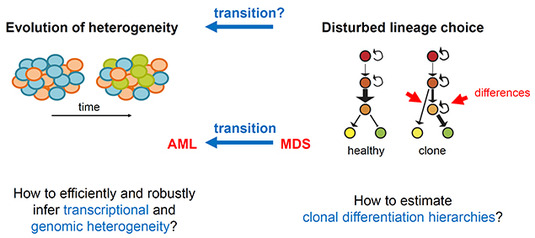A17 Computational models of neoplasmic heterogeneities and lineage choice
Acute myeloid leukemia (AML) often results from the myelodysplastic syndrome (MDS). Here, the differentiation hierarchy from hematopoietic stem cells to mature, functional cells is disturbed. AML patients, again, frequently carry a mixture of different cancer cell types, so-called subclones. This is reflected by a mixture of genomic signatures and heterogeneous transcriptome profiles. Applying statistical and dynamical models to data from our clinical and biological collaborators in this CRC, we want to identify altered differentiation hierarchies of MDS subclones and characterize the development of related heterogeneities in AML while the tumor undergoes evolution.

Figure Legend: Objectives of this project. Left: Inferring transcriptional and genomic heterogeneity in AML, that is the co-existence of at least two distinct cell populations within a tumor, and how it evolves over time. Right: Estimating differentiation and self-renewal rates in healthy and clonal differentiation hierarchies from healthy and MDS patient data.

Prof. Dr. Christiane FuchsHelmholtz Zentrum München, Institute of Computational Biology +49 (0)89 3187-3385 |

Prof. Dr. Fabian TheisHelmholtz Zentrum München, Institute of Computational Biology +49 (0)89 3187-4030 |

